SAGEMCOM BROANDS PPX3610 Pocket Projector User Manual Part 1
SAGEMCOM SAS Pocket Projector Part 1
Contents
- 1. Part 1
- 2. Part 2
- 3. Part 3
- 4. Addendum
Part 1
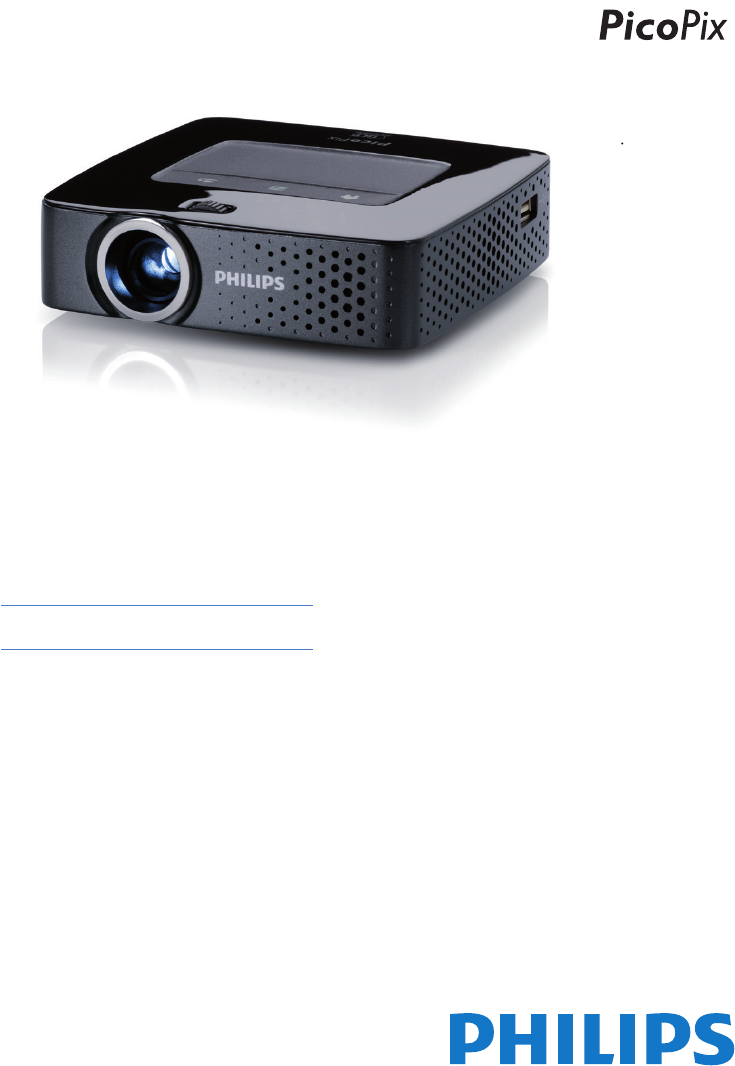
EN
PPX3610
User Manual
Register your product and get support at
www.philips.com/welcome
X PROJECT WIFI

1 Philips · PPX3610
Table of Contents
Overview ................................................... 2
Dear Customer ................................................................... 2
About this User Manual ..................................................... 2
What's in the Box ............................................................... 2
Product Highlights .............................................................. 2
1 General Safety Information................ 3
Setting up the Device ......................................................... 3
Repairs ................................................................................... 3
Power Supply ....................................................................... 4
Wireless Network (WLAN) ............................................ 4
2 Overview............................................... 5
Top of the Device ............................................................... 5
Bottom of the Device ........................................................ 5
Side View ............................................................................... 5
Pico Station ........................................................................... 6
Touchpad / Gestures .......................................................... 7
Remote Control .................................................................. 9
Overview of the Menu Functions ................................. 10
Symbols in the Statusbar ................................................ 10
3 Initial Operation ................................ 11
Setting up the Device ...................................................... 11
Connect Power Supply / Charge Battery ................... 11
Installing or Changing the Batteries of the Remote
Control ............................................................................... 11
Using the Remote Control ............................................ 12
Initial Installation ............................................................... 13
4 Connect to the Playback Device ...... 14
Connecting to Devices with HDMI Output .............. 14
Connecting to an iPhone/iPad/iPod ............................. 14
Connecting to a Computer (VGA) .............................. 15
Connecting Using an Audio/Video (CVBS) Adapter
Cable ................................................................................... 15
Connecting using Component-Video (YPbPr/YUV)
Cable ................................................................................... 16
Directly Connecting Projector to Computer using
WLAN (WiFi Streaming) ............................................... 17
Connecting the headphones .......................................... 17
5 Memory............................................... 18
Inserting a Memory Card ............................................... 18
Connecting USB Storage Medium ................................ 18
Connect to a Computer (USB) .................................... 19
6 Wireless Network (WLAN) ............. 20
Switching Wireless Networking (WLAN) on/off ..... 20
Setting up a Wireless Network (WLAN) .................. 20
Setting up a Wireless Network (WLAN) Using the
Wizard ................................................................................ 21
Digital Living Network Alliance (DLNA) ................... 21
7 Media Playback................................... 22
Video playback .................................................................. 22
Photo Playback ................................................................. 23
Music Playback .................................................................. 24
Office Playback (YOZO Office) ................................... 25
Managing Files ................................................................... 25
8 Digital TV Playback........................... 27
Connecting the Aerial ..................................................... 27
First Playback ..................................................................... 28
Television ............................................................................ 29
9 Android............................................... 30
Calling Android ................................................................. 30
Exiting Android ................................................................. 30
Resetting Android ............................................................ 30
Installing Android-Apps ................................................... 30
Adjust Browser Mode ..................................................... 32
10 Settings............................................... 34
Overview of the Menu Functions ................................. 34
11 Service ................................................ 36
Care Instructions for the Battery ................................. 36
Battery deep discharge .................................................... 36
Cleaning .............................................................................. 37
Device Overheated .......................................................... 37
Update Firmware with Memory Card ......................... 37
Troubleshooting ................................................................ 38
12 Appendix ............................................ 40
Technical Data ................................................................... 40
Accessories ........................................................................ 40
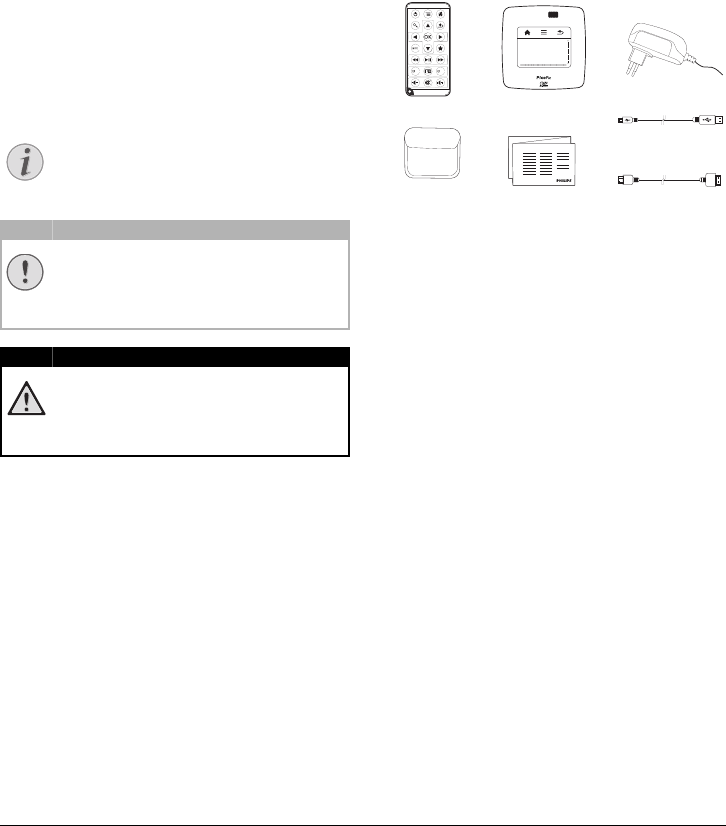
2
Overview
Dear Customer
Thank you for purchasing our Pocket Projector.
We hope you enjoy your device and its many functions!
About this User Manual
With the installation guide on the following pages, you
can start using your device quickly and easily. Detailed
descriptions can be found in the following sections of
this user manual.
Read the entire user manual carefully. Follow all safety
instructions in order to ensure proper operation of
your device. The manufacturer accepts no liability if
these instructions are not followed.
Symbols Used
Troubleshooting
This symbol designates tips that will help you
to use your device more effectively and easily.
Damage to the Device or Loss of Data!
This symbol gives warning of damage to the
device and possible loss of data. This damage
can result from improper handling.
Danger to Persons!
This symbol gives warning of danger to per-
sons. Physical injury or damage can result
from improper handling.
What's in the Box
– Remote Control
– PicoPix Projector
– Power supply
– USB cable
– HDMI cable
– Quick Start Guide
– Pouch
d
e
f
g
bc
a
Product Highlights
Connecting to devices with HDMI output
With the HDMI to mini HDMI cable you can connect
the projector to a computer or laptop (see also Con-
nect to the Playback Device, page 14).
Directly connecting projector to compu-
ter using WLAN (WiFi streaming)
With the software PicoPixWlink you can connect the
projector to a computer or a laptop over your wireless
network. For this purpose, both devices must be con-
nected to the same wireless network (see also Directly
Connecting Projector to Computer using WLAN (WiFi
Streaming), page 17).
Office playback (YOZO Office)
You can display documents with YOZO Office (see also
Office Playback (YOZO Office), page 25).
Notice
CAUTION!
DANGER!

3 Philips · PPX3610
1 General Safety Information
Do not make any changes or settings that are not
described in this user manual. Physical injury or damage
to the device or loss of data can result from improper
handling. Take note of all warning and safety notes indi-
cated.
Setting up the Device
The unit is for indoor use only. The device should be
placed securely on a stable, flat surface. Position all
cables in such a way that no one will stumble on them,
thus avoiding possible injuries to persons or damage to
the device itself.
Do not plug in the device in moist rooms. Never touch
the mains cable or the mains connection with wet
hands.
The device must have sufficient ventilation and may not
be covered. Do not put your device in closed cabinets
or boxes.
Do not place the machine on soft surfaces such as table-
cloths or carpets and do not cover the ventilation slits.
Otherwise the device could overheat or catch fire.
Protect the device against direct sunlight, heat, large
temperature fluctuations and moisture. Do not place
the device in the vicinity of heaters or air conditioners.
Observe the information on temperature and humidity
in the technical data.
When the device is running for a long period of time,
the surface becomes hot and a warning symbol appears
on the projection (see also Symbols in the Statusbar,
page 10). The device behaves as follows:
1The fan turns to maximum level.
2At maximum level of brightness the overheat symbol
appears in the status bar and the device turns auto-
matically to minimum level of brightness.
3At minimal level of brightness the overheat symbol
shows for three seconds in the middle of the screen.
Then the device turns off automatically.
After the device has cooled down, you can continue
playback.
Do not allow liquids to enter into the device. Switch off
the device and disconnect it from the mains supply if liq-
uids or foreign substances end up inside the device.
Have the unit inspected by a technical service depart-
ment.
Always handle the unit with care. Avoid touching the
lens. Never place heavy or sharp objects on the projec-
tor or the power cable.
If the projector gets too hot or emits smoke, shut it
down immediately and unplug the power cable. Arrange
for your device to be investigated by a technical service
centre. To prevent the spread of fire, open flames
should be kept away from the device.
Under the following conditions, a layer of moisture can
appear inside the device which can lead to malfunctions:
• if the device is moved from a cold to a warm
area;
• after a cold room is heated;
• when this device is placed in a damp room.
Proceed as follows to avoid any moisture build-up:
1Seal this device in a plastic bag before moving it to
another room, in order for it to adapt to room con-
ditions.
2Wait one to two hours before you take the device
out of the plastic bag.
The device should not be used in a very dusty environ-
ment. Dust particles and other foreign objects may
damage the unit.
Do not expose the device to extreme vibrations. It may
damage the internal components.
Do not allow children to handle the device without
supervision. The packing materials should be kept out of
the hands of children.
Repairs
Do not repair the device yourself. Improper mainte-
nance can result in injuries or damage to the device.
Your device must be repaired by an authorised service
centre.
Find details of authorised service centres on the war-
ranty card.
Do not remove the type label from your device; this
would void the warranty.
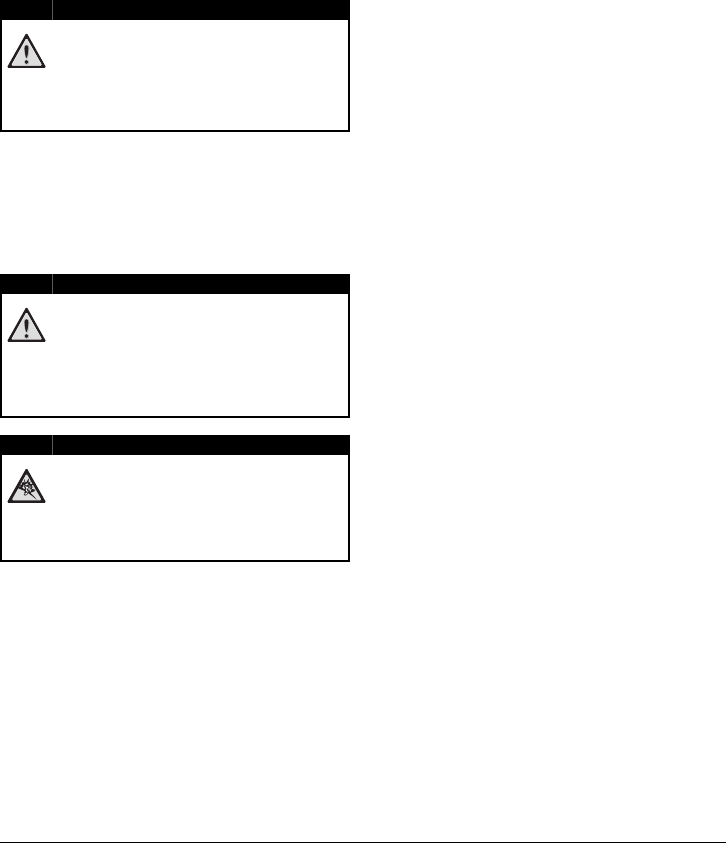
General Safety Information 4
Power Supply
Use only the enclosed power adapter (see chapter Appen-
dix / Technical Data). Check whether the mains voltage of
the power supply matches the mains voltage available at
the setup location. This equipment complies with the volt-
age type specified on the unit.
The capacity of the battery diminishes with time. If the
device functions only with the power supply, the battery
is defective. Contact an authorised service centre to
replace the battery.
Do not try to replace the battery yourself. Incorrect
handling of the battery or using the wrong type of bat-
tery can cause damage to the device or cause injury.
Risk of explosion with incorrect type of
batteries
Do not try to replace the battery yourself.
There is a risk of explosion if the incor-
rect battery type is used.
Switch the device on or off using the power switch
before removing the power supply from the socket.
Turn off the device and remove it from the power sup-
ply before cleaning the surface. Use a soft, lint-free
cloth. Never use liquid, gaseous or easily flammable
cleansers (sprays, abrasives, polishes, alcohol). Do not
allow any moisture to reach the interior of the device.
High Power LED
This device is equipped with an high power
LED (Light Emitting Diode), which emits very
bright light. Do not look directly into the pro-
jector lens. This could cause eye irritation or
damage.
Danger of hearing damage
Do not use the device over a longer time at
high volume – especially when using head-
phones. This could lead to the risks of hearing
damage.
Wireless Network (WLAN)
The functioning of security systems, medical equipment
or sensitive devices can be disrupted by the transmis-
sion power of the device. Observe any usage regula-
tions (or restrictions) in the vicinity of such equipment.
The use of this device can affect the operation of insuf-
ficiently shielded medical devices and hearing aids and
pacemakers through the release of high frequency radi-
ation. Also consult a doctor or the manufacturer of the
medical device to establish whether these are suffi-
ciently shielded from external high frequency radiation.
DANGER!
DANGER!
DANGER!
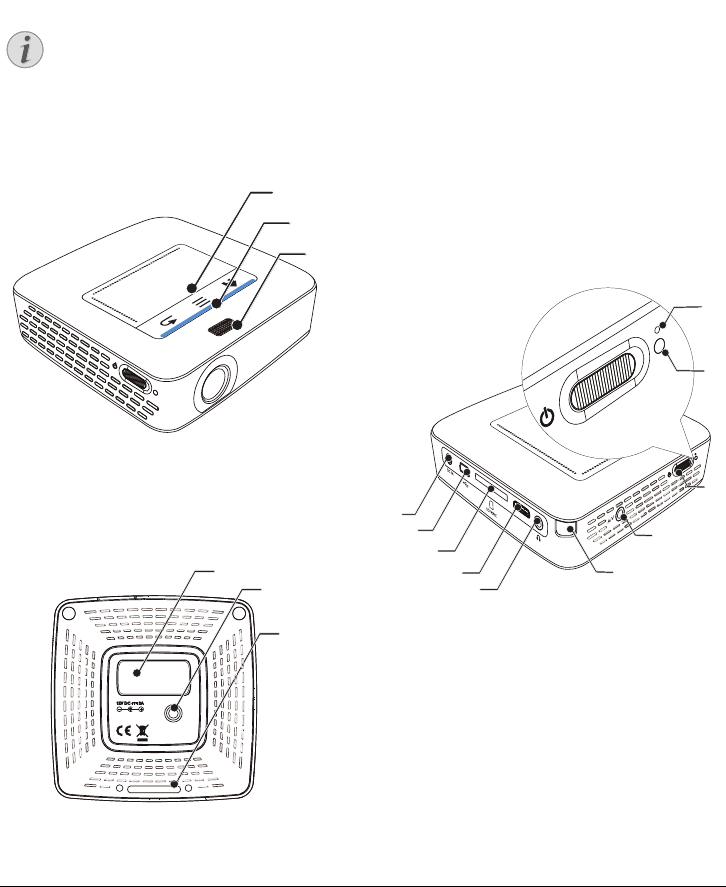
5 Philips · PPX3610
2 Overview
Top of the Device
– Touchpad for navigation and operation of the
mouse pointer (see also Touchpad / Gestures, page 7)
– LED status bar
Blue: device switched on / device in standby
Off: device off
– Focus wheel for image sharpness.
Note that the distance to the projection sur-
face must be a minimum of 0.5 meters and a
maximum of 5 meters. If the Pocket Projector
is located outside of this range, it will not be
possible to focus the image. Turn the focus
wheel carefully so as to avoid damaging the
lens.
c
a
b
Bottom of the Device
– Pico Station connection socket
– Tripod socket
– Pico Station port
b
c
a
Side View
– Reset hole
The Pocket Projector is unresponsive or hung up: insert
a slim, pointy object into the reset hole to trigger a
hardware reset.
– Battery status monitor
Charge indicator with connected power supply:
red: Charging battery
Green: battery is fully charged
– On/Off switch
– A/V port for a playback device
– Remote-control signal receiver
– Audio output – headphone connection or con-
nection for external speakers
– HDMI port for a playback device (with
adapter cable)
– Memory card slot (SD/SDHC/SDXC/
MMC)
– USB port for connection to a computer (data
exchange)
– Power supply port
VGA
Y-Pb-Pr
HDMI
j
i
h
ge
d
c
b
a
f
Notice
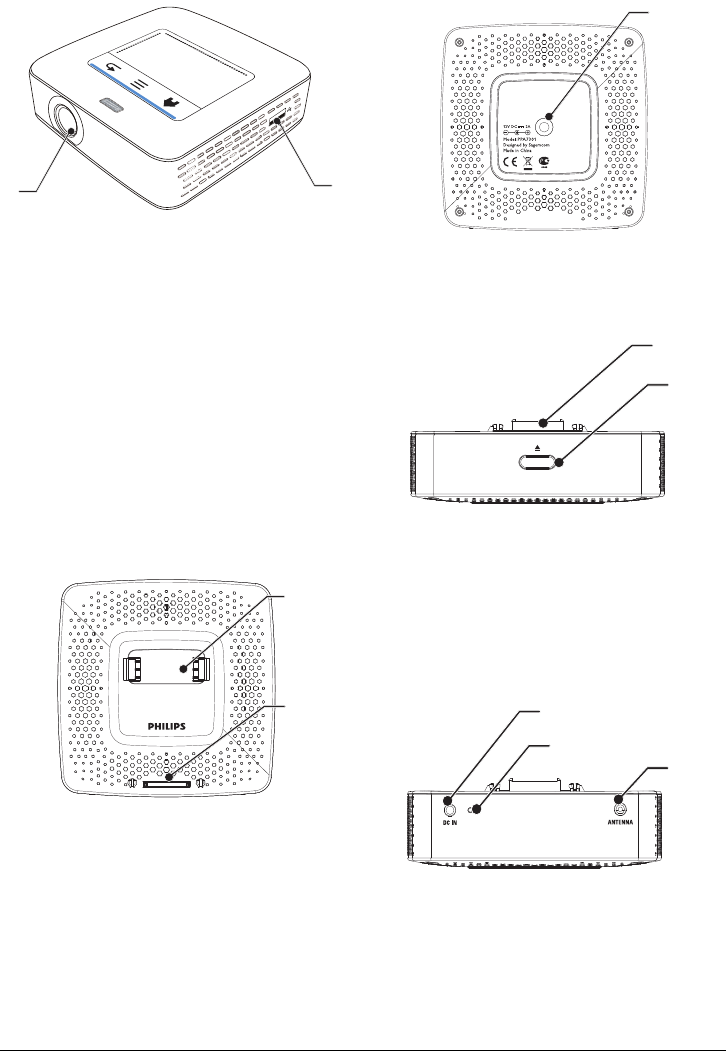
Overview 6
– USB port for a USB storage medium, DVB-T
stick, mouse or keyboard.
– Lens
ba
Pico Station
(not included)
The Pico Station docking station has its own battery,
with which you can extend the replay time of the device.
The inbuilt speakers ensure improved sound quality
during playback. The Pico Station has a DVB-T adapter
so that you can directly connect a DVB-T adapter.
Available as accessories
Pico Station with battery and speakers
................................................ PPA7300 / 253529749
Pico Station with battery, speakers and DVB-T adapter
................................................. PPA7301 / 253532895
Top of the Device
– PicoPix coennction socket
– PicoPix port
b
a
Bottom of the Device
– Tripod socket
a
Front View
– PicoPix port
– Eject button
a
b
Rear View
– Power supply port
– Battery status monitor
red: battery empty
Charge indicator with connected power supply:
red: Charging battery
Green: battery is fully charged
– Aerial socket
c
b
a
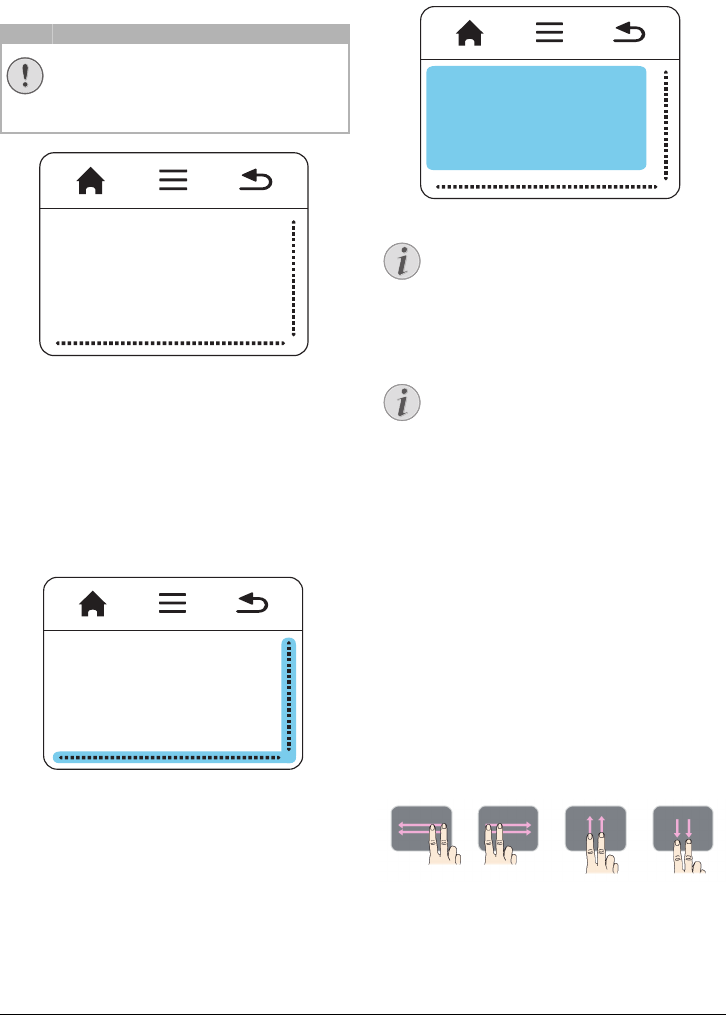
7 Philips · PPX3610
Touchpad / Gestures
The touchpad is a touch-sensitive surface. Touch the
touchpad with one or more fingers to move the cursor,
navigate in the menu, select menu options or carry out
other actions.
Ballpoint Pens!
Do not use a ball-point pen or other objects
to operate the touchpad. Hard and sharp
objects may damage the touchpad.
– Calling the main menu
– Calling the menu
– One menu step back, one directory level back /
cancelling functions
Navigation Area / Scrolling Area
Swipe up and down on the right edge of the touchpad
to use vertical scroll.
Swipe left and right on the bottom edge of the touchpad
to use horizontal scroll.
Input Area
The input area is limited by the navigation area/scrolling
area. You can control the cursor using gestures in the
input area.
Hidden Cursor
After a short time, the cursor fades out. Move
the cursor using a brief gesture in the input
area to reveal the cursor before you call a
function by tapping/clicking.
Connecting a USB Mouse
You can connect a USB mouse to the USB
port on the side of the device.
Gestures
Simple gestures, which you carry out on the touchpad
for quick navigation. Most gestures are carried out with
one or two fingers. Carry out the gestures using your
fingertips.
Move cursor – Swipe over the input area, to move the
cursor. The gesture involves swiping the surface of the
touchpad with the fingertip without exerting any pres-
sure.
Tap / click – Tap briefly in the input area to confirm an
entry. After tapping remove your finger from the touch-
pad. The reaction occurs after you have lifted your fin-
ger. The click is executed at the point where the cursor
is located, even if the cursor is hidden.
Scroll – Swipe over the touchpad with two fingers to
execute the following actions: during music playback
rewind and fast forward / during miniature photos over-
view go to previous or next page.
CAUTION!
Notice
Notice
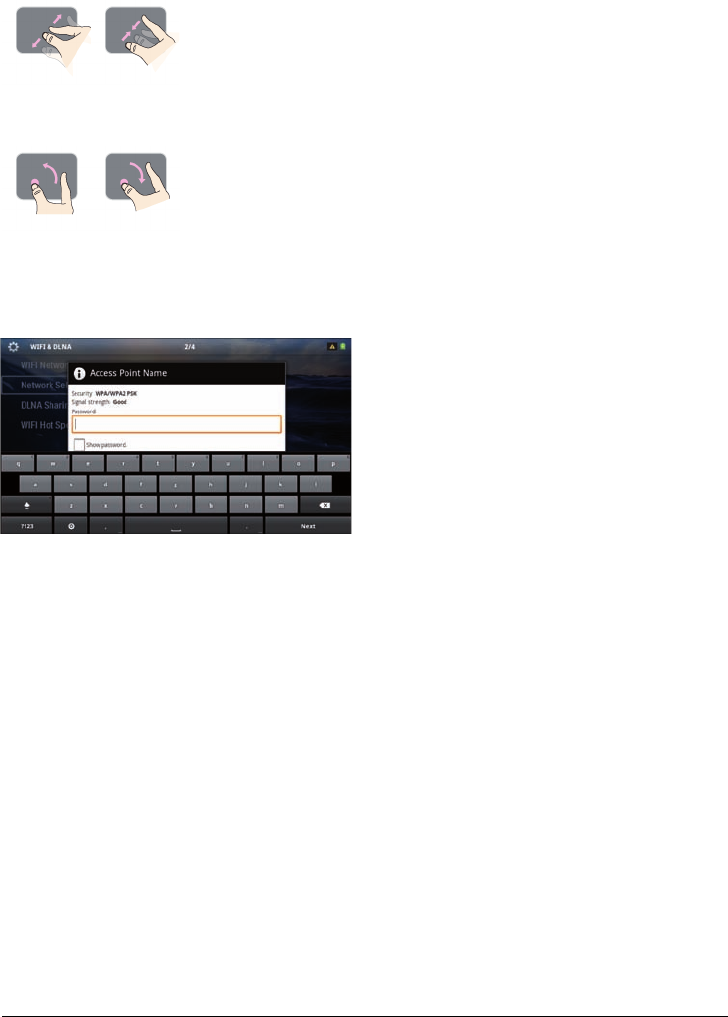
Overview 8
Zoom – Place the thumb and forefinger in the middle
of the input area and separate them slowly to magnify
an image or document. Zoom – Place the thumb and
forefinger in the corners of the input area and bring
them slowly together to magnify an image or document.
Rotate – Touch the touchpad with the thumb and
swipe the forefinger in a circular pattern in the direction
in which you want to rotate the image.
Software Keyboard
1Click in the input field (see also Touchpad / Ges-
tures, page 7) using the touchpad or a mouse.
2The software keyboard appears..
3Using the touchpad or a mouse enter the text on the
software keyboard.
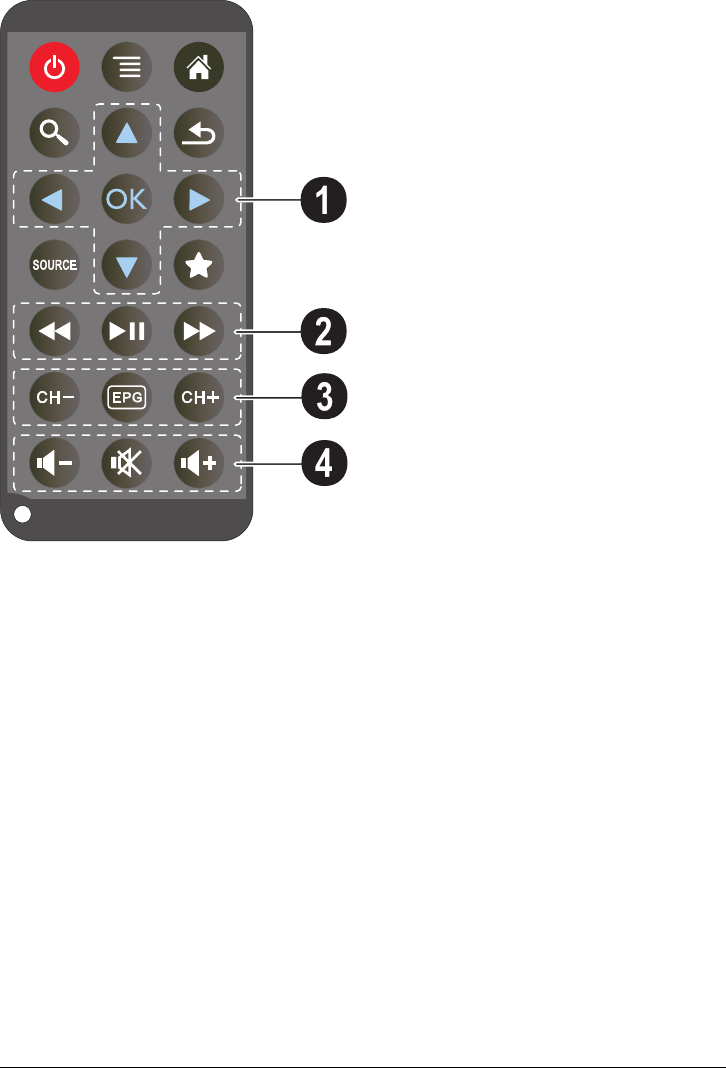
9 Philips · PPX3610
Remote Control – Switches the device hibernation mode
– Call the menu
– Call the main menu
– Call the search menu
– One menu step back, one directory level back /
cancelling a function
– Switch to the external video input HDMI,,
or VGA
– DVB-T mode: change to favourites
Navigation keys
– Confirms selection
, – Navigation keys / navigate the menu /
modify settings
– Modify settings / during music playback select
previous, next title
– During music playback adjust volume level /
during video playback review, cue
Playback keys
– Rewind
– Start / stop playback
– Fast-forward
DVB-T keys
– Select previous channel
– Call electronic program guide
– Select the next channel
Volume keys
– Decrease the volume
– Mute the sound
– Increase the volume
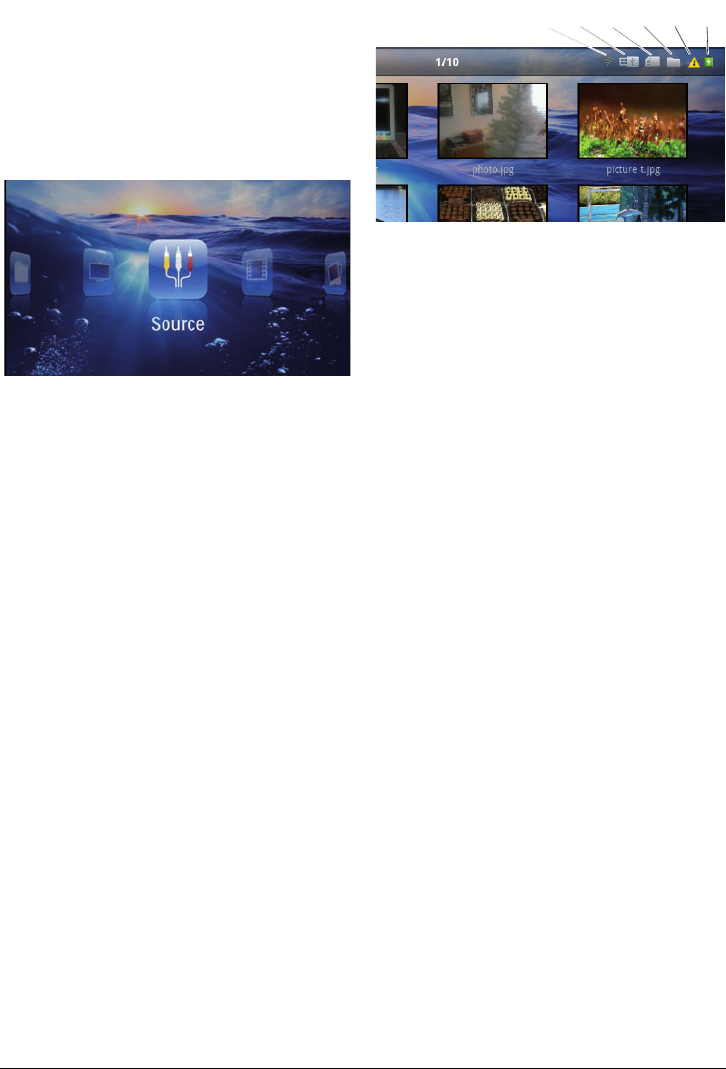
Overview 10
Overview of the Menu
Functions
1After switching on the device the main menu
appears.
2Select the desired menu using the navigation keys
.
3Confirm with .
4By pressing the key you will return to the main
menu.
Source – Switch to the external video input HDMI,
, or VGA
Videos – Selecting files for video playback
Pictures – Selecting files for the slideshow
Music – Selecting music files for playback
Android – Call the android operating system
Settings – Configure settings for playback and for
the device
Folder View – Selecting files for Playback. Copy or
Delete Files (Mark the files with and confirm
using ).
Digital TV – Television
Symbols in the Statusbar
123456
– WLAN status display
– USB storage medium
– Memory card
– Internal memory
– Overheat symbol
– Charge level of the internal battery. The icon will
be red, when the battery needs to be recharged.
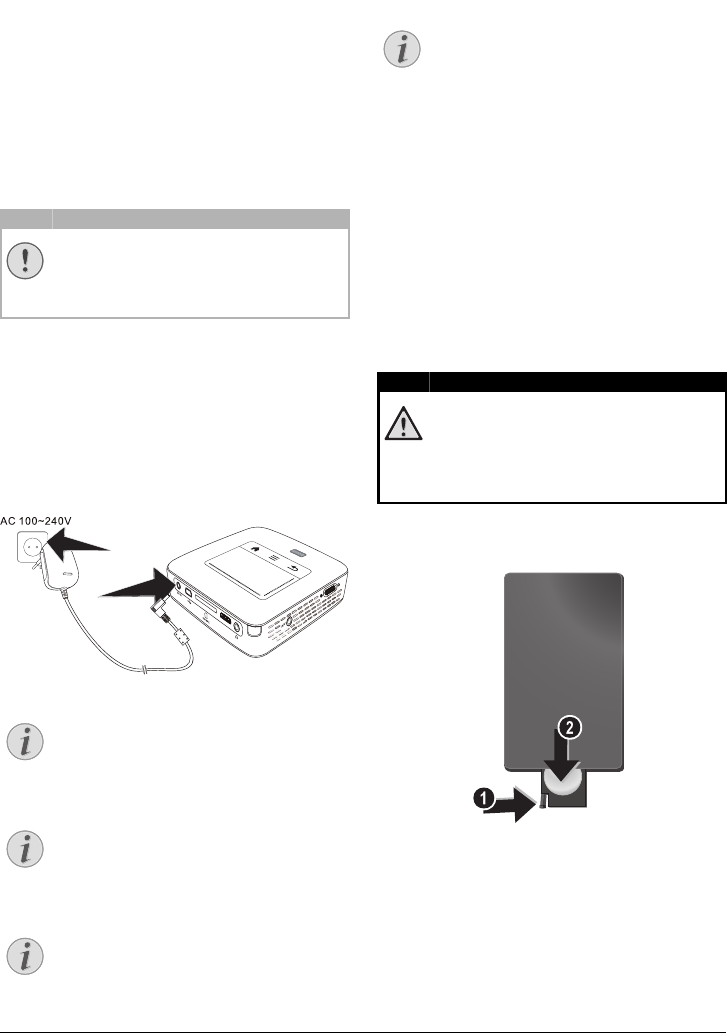
11 Philips · PPX3610
3 Initial Operation
Setting up the Device
You can position the device so that it lies flat on a table
in front of the projection surface; it is not necessary to
tilt it towards the projection surface. The device com-
pensates for the distortion from the slanted projection
(pincushion distortion).
Connect Power Supply /
Charge Battery
Mains Voltage at the Site of Installation!
Check whether the mains voltage of the
power supply matches the mains voltage avail-
able at the setup location.
1Insert the small plug of the power supply into the
socket on the rear side of your device.
2Plug the power supply into the mains.
3During the charging process, the indicator light on
the side of the device will be red. When the battery
is fully charged, it will turn green.
4Charge the built-in battery completely before using
for the first time. This will prolong the life of the bat-
tery.
VGA
Y-Pb-Pr
HDMI
Pico Station
The battery of the Pico Station will not be
charged while the projector is in use.
Charging via Pico Station
The battery of the projector will not be
charged while the projector is in use.
Operate via Pico Station
The battery of the Pocket Projector is empty:
Connect the Pico Station to use the Pocket
Projector.
Battery Empty
The battery of the Pocket Projector is empty:
Connect the Pico Station or the power supply
to use the Pocket Projector.
Connect the power supply to the Pocket Pro-
jector or the Pico Station to recharge the bat-
tery.
Disconnect the power supply only if the
Pocket Projector is sufficiently charged. Oth-
erwise the Pocket Projector turns off.
Installing or Changing the
Batteries of the Remote
Control
Risk of Explosion with Incorrect Type of
Batteries
Only use the CR 2025 type battery.
There is a risk of explosion if the incor-
rect battery type is used.
1To access the battery, disengage the locking mecha-
nism () and slide out the battery compartment
().
CAUTION!
Notice
Notice
Notice
Notice
DANGER!
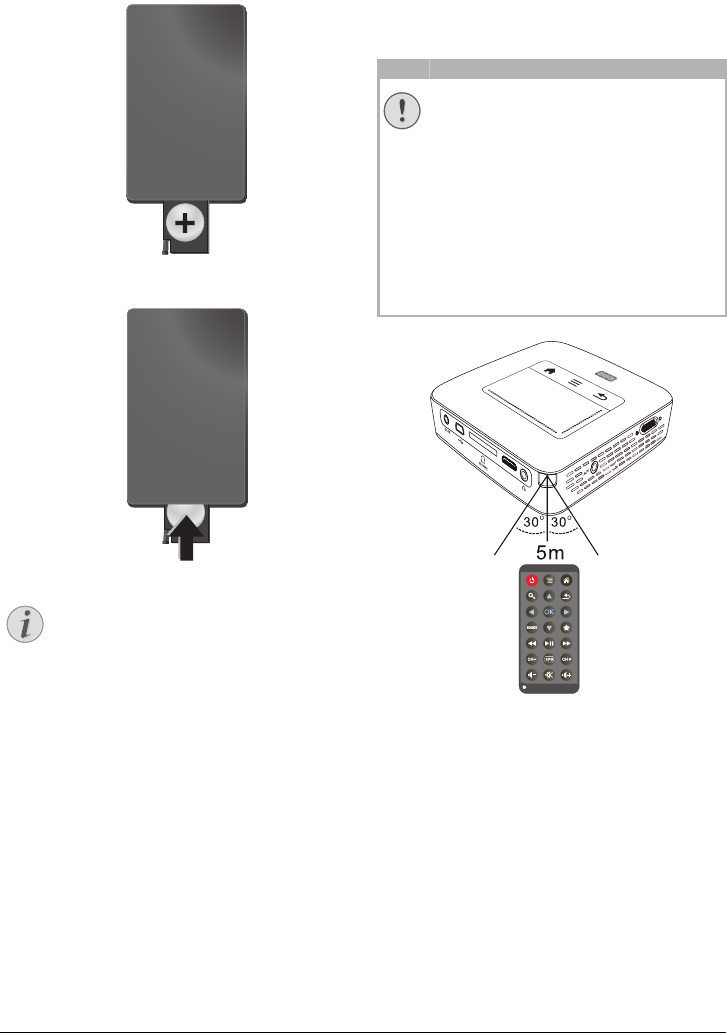
Initial Operation 12
2Insert the new batteries into the battery compart-
ment with the positive and negative poles as shown
on the back of the remote control. Make sure the
polarities(+ and -) are aligned correctly.
3Push the battery compartment back into the remote
control until the locking mechanism engages.
Normally the batteries will last for around
one year. If the remote control stops working,
please replace the batteries. If the device is
not used for a long time, take out the batter-
ies. This will prevent leakage and possible
damage to the remote control.
The used batteries should be disposed of
according to the recycling regulations of your
country.
Using the Remote Control
Point the remote control at the remote sensor on the
back of the device. The remote can be used within an
angle of 60 degrees and up to 5 meters from the device.
When using the remote control, no obstacle should be
placed between the remote control and remote sensor.
VGA
Y-Pb-Pr
HDMI
Notice
CAUTION!
• The improper use of batteries can lead
to overheating, explosion, risk of fire
and injury. Leaking batteries can possibly
damage the remote control.
• Never expose the remote control to
direct sunlight.
• Avoid deforming, dismantling or charg-
ing the batteries.
• Avoid exposure to open fire and water.
• Replace empty batteries immediately.
• Remove the battery from the remote
control if not in use for long periods of
time.

13 Philips · PPX3610
Initial Installation
1Push for about 3 seconds the on/off switch on the
side to turn the device on.
2Turn the device towards a suitable projection sur-
face or wall. Note that the distance to the projection
surface must be a minimum of 0.5 meters and a max-
imum of 5 meters. Make sure the projector is in a
secure position.
3Use the focus wheel on the top to adjust the image
sharpness.
4Select the desired menu language using .
5Confirm with .
The Main Menu Appears Instead of
the Language Selection
The device has already been installed. In
order to change the menu language, pro-
ceed as follows:
1Use the navigation keys to select Set-
tings.
2Confirm with .
3Select with Language.
4Confirm with .
5Select the desired language with .
6Confirm with .
7Exit with .
Notice
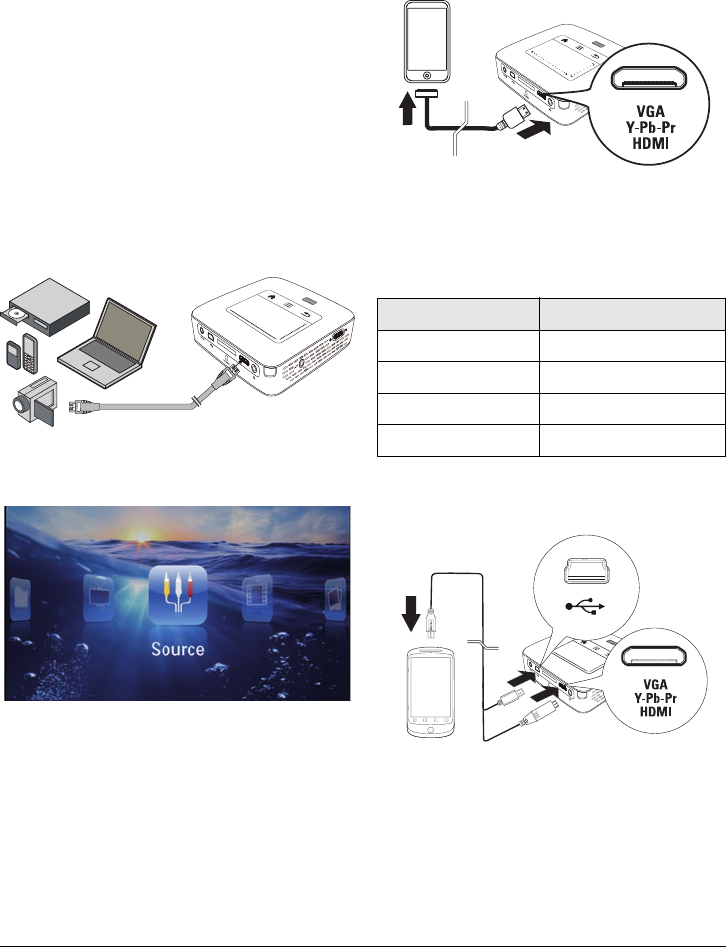
Connect to the Playback Device 14
4 Connect to the Playback Device
Only use the supplied cable or cables that are available
as accessories to connect the projector.
Supplied cables
HDMI cable
USB cable
Cables available as accessories
Component Video Cable YUV / YPbPr
.............................................. (PPA1210 / 253447083)
Video-(CVBS) cable ................... (PPA1320 / 253526178)
VGA cable ................................... (PPA1250 / 253447070)
iPhone/iPad/iPod-HDMI cable . (PPA1280 / 253447091)
iPhone/iPad/iPod-A/V cable...... (PPA1160 / 253372471)
MHL cable .................................... (PPA1240 / 253520048)
Connecting to Devices with
HDMI Output
Use the HDMI to mini HDMI cable to connect the pro-
jector to a computer or laptop.
VGA
Y-Pb-Pr
HDMI
1Switch the device on using the on/off switch on the
side.
2After the initial screen the main menu appears.
3Select Menu > Source and switch to HDMI.
4Connect the HDMI cable to the projector's HDMI
socket.
5Connect the cable to the mini-HDMI socket of the
playback device.
Connecting to an iPhone/
iPad/iPod
Use the iPhone/iPad/iPod-HDMI cable (not supplied) to
connect the projector to an iPhone/iPad/iPod.
VGA
Y-Pb-Pr
HDMI
1Select Menu > Source and switch to Component.
2Connect the cable to the projector's HDMI socket.
3Connect the cable to the playback device.
Supported devices
All devices with 30-pin dock connector are supported.
Device Generation
iPod nano up to generation 6
iPod touch up to generation 4
iPhone up to generation 4
iPad up to generation 2
Connecting to Smartphone
Use the HML cable (not supplied) to connect the pro-
jector to a smartphone.
VGA
Y-Pb-Pr
HDMI
1Select Menu > Source and switch to HDMI.
2Connect the cable to the projector's HDMI and
sockets.
3Connect the cable to the playback device.
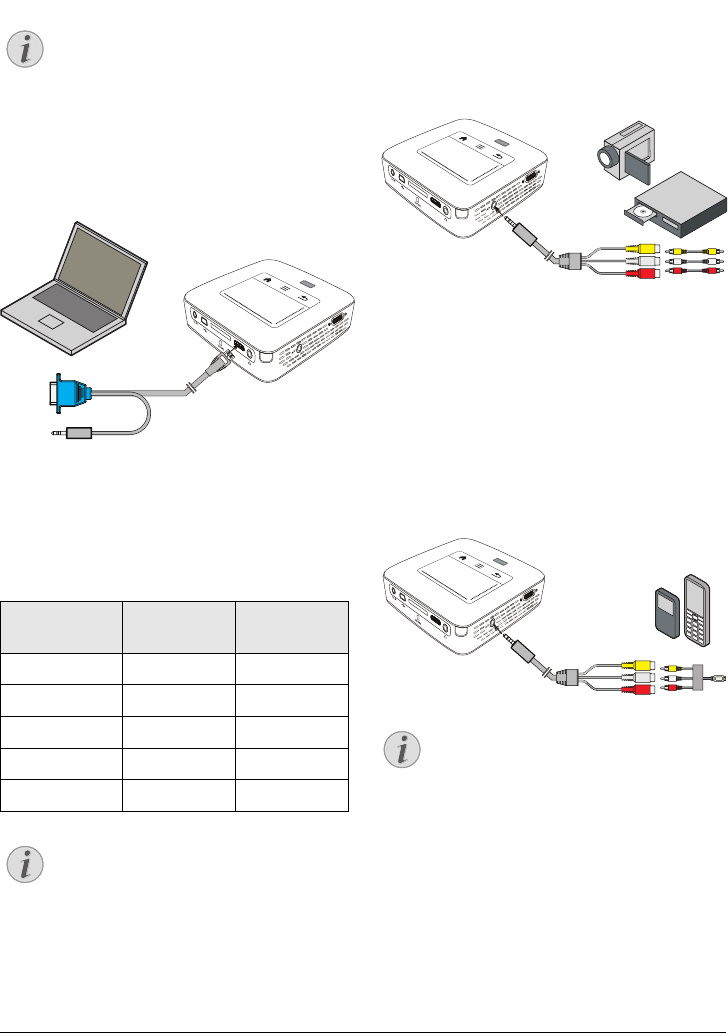
15 Philips · PPX3610
Connecting to a Computer
(VGA)
Many laptops do not activate the external
video output automatically when you connect
a second display such as a projector. Check
your laptop's manual to find out how to acti-
vate the external video output.
Use the VGA cable (not included) to connect the pro-
jector to a computer, laptop, or some PDAs. The pro-
jector supports the following resolutions: VGA/SVGA/
XGA. For best results, set the computer's resolution to
SVGA (800x600).
VGA
Y-Pb-Pr
HDMI
1Connect the VGA cable to the projector's HDMI
socket.
2Connect the VGA plug to the VGA socket of the
computer and the audio plug to the computer's
audio output.
3Adjust the computer's resolution to the correct set-
ting and switch the VGA signal to an external moni-
tor. The following resolutions are supported:
Resolution Image
refresh rate
VGA 640 x 480 60 Hz
SVGA 800 x 600 60 Hz
XGA 1024 x 768 60 Hz
WXGA 1280 x 768 60 Hz
FULL HD 1920 x 1080 60 Hz
Screen Resolution
You can obtain the best results with the
800¦×¦600 (60Hz) resolution.
4Select Menu > Source and switch to VGA.
Connecting Using an Audio/
Video (CVBS) Adapter
Cable
Use the projector's audio/video adapter cable (A/V
cable) (not included) to connect camcorders, DVD
players or digital cameras. The jacks for these devices
are yellow (video), red (audio right) and white (audio
left).
VGA
Y-Pb-Pr
HDMI
1Connect the supplied A/V cable to the socket of
the projector.
2Connect the video device's audio/video sockets to
the A/V cable using a conventional composite video
(RCA) cable.
3Select Menu > Source and switch to AV.
Connecting to mobile multimedia devices
Some video devices (e.g.: pocket multimedia players, ...)
require specific connection cables. There are either
supplied with the device or acquired from the manufac-
turer of the multimedia device. Please note that only the
original cables from the device manufacturer may func-
tion.
VGA
Y-Pb-Pr
HDMI
Switching to the Multimedia Device Sig-
nal Output
See the multimedia device instruction manual
to find out how to switch the signal output to
this jack.
Notice
Notice
Notice